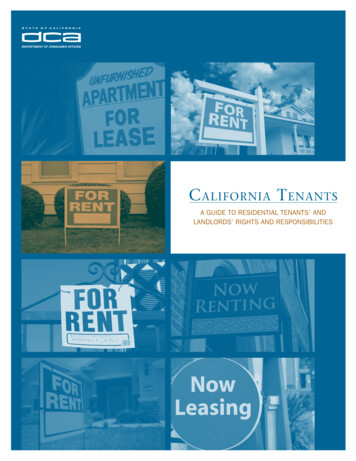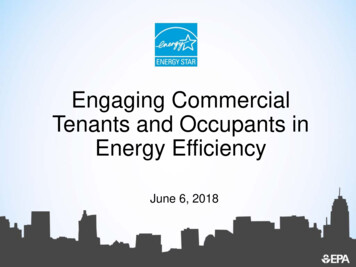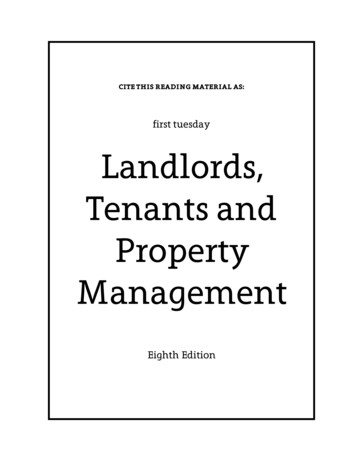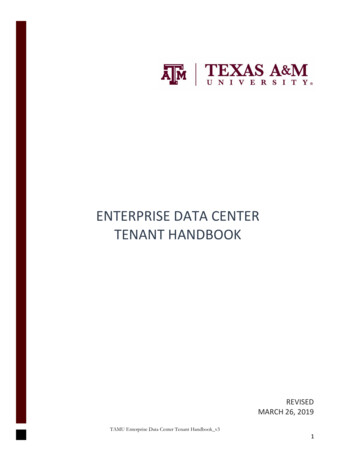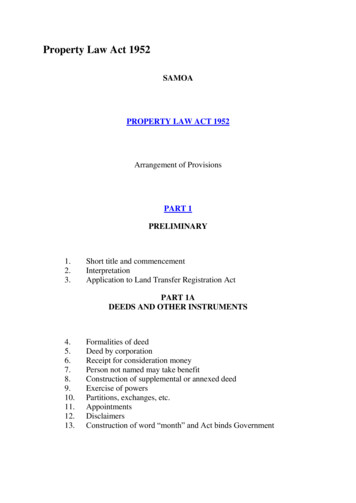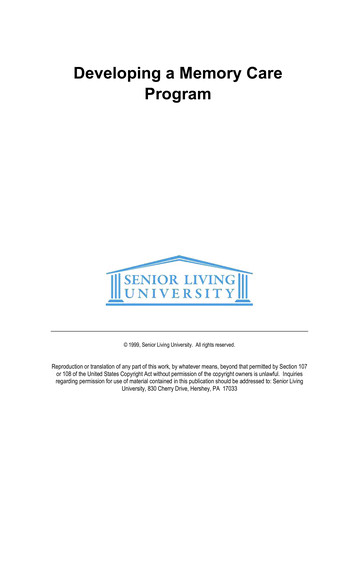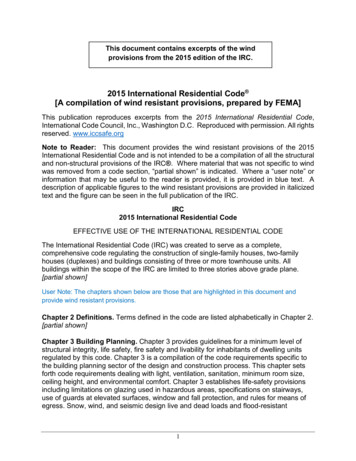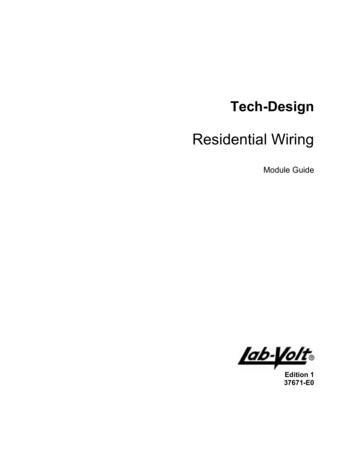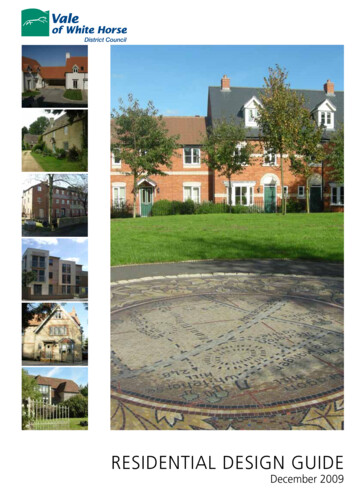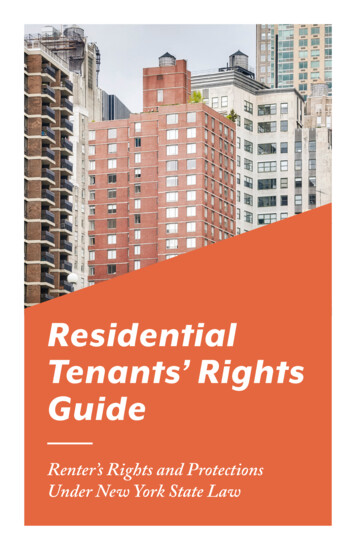
Transcription
ResidentialTenants’ RightsGuideRenter’s Rights and ProtectionsUnder New York State Law
2
Dear Friends:The contract between a tenant andlandlord, whether based on a writtenlease or a handshake, is one of themost common and important dealsmade across our state. It defineshow renters will enjoy their home,how owners will maintain theirproperty, and it can even affect aneighborhood’s stability.In New York State, there are severaldifferent laws governing thisrelationship, which can vary depending on the county or townwhere you live. This booklet explains many of these laws youneed to know and provides resources where you can find moreinformation about landlord and tenant issues. If you havequestions about any of the material covered in this guide,or you need our assistance with a tenant matter, please donot hesitate to contact my office at (800) 771-7755 or visit mywebsite at ag.ny.gov.Sincerely,3
4 Residential Tenant’s Rights Guide
Table of ContentsTypes of Housing. 6Leases.10Rent. 16Lease Succession or Termination. 26Habitability and Repairs. 38Safety.44Utility Services. 50Tenants’ Personal Protections.52Manufactured and Mobile Homes. 58Finding An Apartment. 62Resources. 64Table of Contents 5
Types of HousingThe two types of rent regulation in New York State are rent control andrent stabilization. An individual tenant’s rights will depend, in part,upon which regulations apply, although some apartments may havemultiple laws governing their tenancies. While tenants in rent regulatedor government subsidized apartments have special rights, many rulesand laws apply to both unregulated and regulated apartments.To find out whether an apartment is regulated,contact the New York State Division of Housingand Community Renewal atportal.hcr.ny.gov/app/ask6 Residental Tenant’s Rights Guide
Rent Regulated HousingRent ControlRent control limits the rent an owner may charge for an apartmentand restricts the right of the owner to evict tenants. The rent controlprogram applies to residential buildings constructed before February1947 in municipalities that have not declared an end to the postwarrental housing emergency. Rent control is still in effect in New YorkCity and parts of Albany, Erie, Nassau, Rensselaer, Schenectady, andWestchester counties.For an apartment to be under rent control, the tenant or the tenant’slawful successor (such as a family member, spouse, or adult lifetimepartner) must have been living there continuously since before July 1,1971 (and in some situations since April 1, 1953). When a rent controlledapartment is vacated in New York City or most other localities,it becomes rent stabilized. In New York City, each rent controlledapartment has a maximum base rent that is adjusted every two yearsto reflect changes in operating costs, but tenants’ rents cannot exceeda Maximum Collectible Rent, which is adjusted annually and based onan average of the past five years of Rent Guideline Board orders forone year leases or 7.5% (whichever is lower). Tenants may challengeincreases if the Maximum Collectible Rent to the Maximum Base rentbeing charged by the landlord exceeds the legal regulated rent, thebuilding has housing code violations, the owner’s expenses do notwarrant an increase, or the owner is not maintaining essential services.Rent Control:Limits the rent an owner may charge for an apartmentand restricts the right of the owner to evict tenants.The rent control program applies to residential buildingsconstructed before February, 1947 in municipalities that havenot declared an end to the postwar rental housing emergency.Types of Housing 7
Rent StabilizationIn New York City, apartments are generally under rent stabilization ifthey are: An apartment that is not otherwise rent controlled in a buildingbuilt before January 1, 1974 with six or more units; A formerly rent controlled apartments that became vacantwithout a lawful successor; In a building with three or more apartments constructed orextensively renovated on or after January 1, 1974 with special taxbenefits, such as 421-a or J-51 tax abatements.Outside New York City, rent stabilized apartments are generally foundin buildings with six or more apartments that were built before January1, 1974.Local Rent Guidelines Boards in New York City, Nassau, Rockland, andWestchester counties set maximum rates for rent increases once a yearwhich are effective for one or two year leases beginning on or afterOctober 1 each year. Tenants in rent stabilized apartments are entitledto required essential services and lease renewals on the same termsand conditions as the original lease and may not be evicted except ongrounds allowed by law.As of June 15, 2019, other localities are now able to enact their own rentstabilization laws if the locality declares a housing emergency.8 Residential Tenant’s Rights Guide
Government-Financed HousingThe Mitchell-Lama housing program provides rental and cooperativehousing for middle-income tenants statewide. Tenants must meeteligibility requirements, including income, family size, and apartmentsize for both state and city-sponsored Mitchell-Lama developments.Public Housing is a federally funded program in which state-charteredauthorities develop and manage public housing developments,subject to federal, state, and local laws and regulations. Tenants inpublic housing are entitled to an administrative grievance processadministered by the local housing authority before their tenancies maybe terminated for cause. However, tenants may be brought to courtdirectly for nonpayment of rent without an administrative hearing.The Section 8 Housing Assistance Payments program is a federal rentand mortgage subsidy program that assists eligible low-income ordisplaced families, senior citizens, and persons living with disabilities inobtaining housing nationwide. Families receive a rental subsidy, knownas a housing assistance payment, or a mortgage subsidy towardpayments to purchase a home, equal to the difference between theirshare of the rent, (based on their income) and the approved rent ormortgage for the unit. Eligible families and individuals are subject tostatutory income limits.Special Types of Housing Manufactured and mobile home parks’ owners and tenantsare governed by Real Property Law § 233 (“Mobile Homeowner’sBill of Rights”). The Division of Housing and Community Renewal(DHCR) enforces compliance with this law. New York City loft owners and tenants are governed byMultiple Dwelling Law, Article 7-C, enforced by the New York CityLoft Board. New York City residential hotel owners and tenants aregoverned by the rent stabilization law, enforced by the DHCR.Types of Housing 9
LeasesA lease is a contract between a landlord and a tenant that containsthe terms and conditions of the rental. It cannot be changed while it isin effect unless both parties agree. Leases for apartments that are notrent stabilized may be oral or written. To avoid disputes, the partiesmay wish to enter into a written agreement. A party must sign the leaseto be bound by its terms. An oral lease for more than one year cannotbe legally enforced (General Obligations Law § 5-701).At a minimum, leases should identify the premises, specify the namesand addresses of the parties, the amount and due dates of the rent, theduration of the rental, the conditions of occupancy, and the rights andobligations of both parties. Except where the law provides otherwise,a landlord may rent on such terms and conditions as are agreed toby the parties. Any changes to the lease should be initialed by bothparties.New York City rent stabilized tenants are entitled to receive a fullyexecuted copy of their signed lease from their landlords within 30 daysof the landlord’s receipt of the lease signed by the tenant. The lease’sbeginning and ending dates must be stated. Rent stabilized tenantsmust also be given a rent stabilization lease rider, prepared by DHCR,which summarizes their rights under the law and provides specificinformation on how the rent was calculated.10 Residential Tenant’s Rights Guide
Lease ProvisionsLeases must use words with common and everyday meanings andmust be clear and coherent. Sections of leases must be appropriatelycaptioned and the print must be large enough to be read easily.(General Obligations Law § 5-702; NY C.P.L.R. § 4544.)The following lease provisions are not allowed : Exempting landlords from liability for injuries to persons orproperty caused by the landlord’s negligence, or that of thelandlord’s employees or agents (General Obligations Law § 5-321); Waiving the tenant’s right to a jury trial in any lawsuit brought byeither of the parties against the other for personal injury or propertydamage (Real Property Law§ 259-c); Requiring tenants to pledge their household furniture as securityfor rent (Real Property Law § 231); Exempting landlords from mitigating the damages of a tenantvacating the premises before the lease expires (Real Property Law§ 227-e); Waiving the Warranty of Habitability (Real Property Law § 235-b);and Restricting a tenant from living with their immediate familymembers and/or one additional occupant and the occupant’sdependent children (Real Property Law § 235-f ).If a lease states that the landlord may recover attorney’s fees and costsincurred, a tenant automatically has a reciprocal right to recover thosefees as well (Real Property Law § 234). If the court finds a lease or anylease clause to have been unconscionable at the time it was made, thecourt may refuse to enforce the lease or the clause in question (RealProperty Law § 235-c).Leases 11
Renewal LeasesNon-Rent Regulated Lease RenewalsFor non-rent regulated apartments, the landlord does not have torenew the lease.A lease may contain an automatic renewal clause. In such case, thelandlord must give the tenant advanced notice of the existence of thisclause between 15 and 30 days before the tenant is required to notifythe landlord of an intention not to renew the lease.(General Obligations Law § 5-905).If the landlord of the non-regulated unit intends to renew the lease witha rent increase of more than 5%, or does not intend to renew the lease,they must provide advanced written notice: If you have lived in your apartment two or more years, or if youhave a two-year lease, your landlord must provide you with 90days advanced written notice before raising your rent or notrenewing your lease; If you have lived in your apartment for more than one year, butless than two years, your landlord must provide you with 60 daysadvanced notice before raising your rent or not renewing yourlease; or If you have lived in your apartment for less than one year, or havea lease for less than one year, your landlord must provide you with30 days advanced notice before raising your rent or not renewingyour lease. (Real Property Law § 226-c).12 Residential Tenant’s Rights Guide
Regulated Renewal LeasesRent stabilized tenants have a right to a one- or two-year renewallease, which must be on the same terms and conditions as the priorlease, unless a change is mandated by a specific law or regulation. Alandlord’s acceptance of a Section 8 subsidy is one such term whichmust be continued on a renewal lease. Landlords may refuse to renewa rent stabilized lease only under certain enumerated circumstances,such as when the tenant is not using the premises as their primaryresidence. For New York City rent stabilized tenants, the landlord mustgive written notice to the tenant of the right to renewal by mail orpersonal delivery not more than 150 days and not less than 90 daysbefore the existing lease expires.After the notice of renewal is given, the tenant has 60 days in whichto accept. If the tenant does not accept the renewal offer within theprescribed time, the landlord may refuse to renew the lease and seekto evict the tenant through court proceedings. If the tenant acceptsthe renewal offer, the landlord has 30 days to return the fully executedlease to the tenant.Leases 13
Month-to-Month TenantsNon-rent regulated renters who do not have leases and pay rent on amonthly basis are called “month-to-month” tenants. Tenants who staypast the end of a lease are treated as month-to-month tenants if thelandlord accepts a rent payment (Real Property Law § 232-c).A month-to-month tenancy may be terminated by either party. If thelandlord plans to terminate, they must give notice on the same timelineas terminating non-regulated leases (as described on the previouspage). Outside of New York City, the tenant must give one month’snotice to terminate the tenancy.Landlords do not need to explain why the tenancy is being terminated,they only need to provide notice that it is, and that refusal to vacatewill lead to eviction proceedings. Such notice does not automaticallyallow the landlord to evict the tenant. A landlord may raise the rent ofa month-to-month tenant with the consent of the tenant. If the tenantdoes not consent, however, the landlord can terminate the tenancy bygiving appropriate notice. (Real Property Law § 232-a and § 232-b).14 Residential Tenant’s Rights Guide
Rent 15
RentRent ChargesWhen an apartment is not rent regulated, a landlord is free to chargeany rent agreed upon by the parties. If the apartment is subject to rentregulation, the initial rent and subsequent rent increases are set by law,and may be challenged by a tenant at any time. However, recoveryof rent overcharge is limited to either four or six years preceding thecomplaint depending on when the complaint is made.16 Residential Tenant’s Rights Guide
Late FeesA rent payment can only be considered late if it is received more thanfive days after it is due. The most your landlord can charge as a late feeis 50 or 5% of your monthly rent, whichever is less (Real Property Law§ 238-a).Tenants can use the failure by the landlord to provide this notice as anaffirmative defense in a nonpayment of rent case.ReceiptsLandlords must provide tenants with a written receipt when rent is paidby cash, money order, cashier’s check, or in any form other than thepersonal check of a tenant. Tenants paying rent by personal check mayrequest in writing a rent receipt from the landlord. The receipt muststate the payment date, the amount, the period for which the rent waspaid, and the apartment number. The receipt must be signed by theperson receiving the payment and state his or her title. (Real PropertyLaw § 235-e). After the tenant requests a receipt one time, the landlordmust provide a receipt every month. The landlord also must keep proofof cash rent receipts for 3 years.Rent 17
Rent IncreasesRent Increases for Non-Regulated ApartmentsIf the landlord of a non-regulated unit intends to increase the rent bymore than 5%, they must provide advanced written notice of either30, 60, or 90 days depending on how long the tenant has been inoccupancy (see section on Renewal Leases).Rent Increases for Regulated ApartmentsMaximum rent increases for rent stabilized apartments are set eachyear by local Rent Guidelines Boards.Landlords are no longer permitted to increase rent in a rent-regulatedunit by 20% when it becomes vacant (the ‘vacancy bonus’). The related‘longevity bonus,’ (when the departing tenant has lived in the unit foreight years or more) is also prohibited.Additionally, in most cases landlords are no longer allowed to take anapartment out of rent regulation when the rent exceeds the “high-rentthreshold” and the apartment becomes vacant. Also, deregulation isno longer permitted in most cases if the tenant is considered “highincome.” (There are a small number of exceptions to the high-rent andhigh-income deregulation prohibitions for certain new buildings thatreceive tax abatements.)Apartments that were deregulated before June 14, 2019 will continue tobe so.Tenants should check their rent history to potentially challenge both thederegulation of their apartment and the rent currently being charged.To check your rent history, call the Office of Rent Administration at (718)739-6400, or visit portal.hcr.ny.gov/app/ask.18 Residential Tenant’s Rights Guide
Substantial Improvements in Rent-Regulated Units:Major Capital Improvements (MCIs)For certain types of building-wide major capital improvements (MCIs)that benefit all of the tenants in a building (such as the replacement ofa boiler or plumbing) the landlord may apply to DHCR to increase therent of their rent stabilized tenants. The amount that a landlord canraise tenants’ rents due to MCIs is now capped at 2% of their currentrent per year, and there is no retroactive amount. This cap applies toMCI increases not collected yet that were approved after June 16, 2012.Additionally, MCI increases are now temporary and will be removedfrom tenants’ rents after 30 years.MCI increases cannot be added to your rent if there are any“hazardous” or “immediately hazardous” violations at your building.Your landlord must fix these violations before any MCI can beauthorized by state regulators.MCI increases are not permitted if fewer than 35% of the apartments inthe building are rent regulated.Rent 19
Individual Apartment Improvements (IAIs)Landlords are also permitted to increase rents for improvements madeto individual apartments (for example, new flooring, new fixtures orother improvements). Typically, these improvements occur while theunit is vacant, but can also be made in occupied units with writtenapproval from the tenant. To increase the rent because of an IAI, thelandlord must take before and after photos, maintain permanentrecords of the improvement, and submit documentation to the state.The amount by which the landlord can increase the rent is determinedby how much the improvements cost. In buildings that contain more than 35 apartments, the landlordcan collect a permanent rent increase equal to 1/180th of the costof the improvement (maximum 83.33). In buildings that contain 35 apartments or less, the landlord maycollect a permanent rent increase equal to 1/168th of the cost ofthe IAI (maximum 89.29).Before a landlord can collect a rent increase due to an IAI, they mustfirst fix any “hazardous” or “immediately hazardous” violations in theapartment.For occupied units, the tenant’s written consent must be on a DHCRform.The landlord must use licensed contractors not affiliated by commonownership between the contractor and the landlord to perform anywork it intends to count as an IAI.A landlord can only claim up to three IAIs in a 15-year period, total costseligible for a rent increase calculation cannot exceed 15,000. IAIs aretemporary and must be removed from your rent after 30 years.A landlord also may increase the rent because of hardship or increasedlabor costs.20 Residential Tenant’s Rights Guide
Rent Increase ExemptionsTenants who are senior citizens (62 or older) or living with a disabilityand living in rent regulated, Low-Income Housing Tax Credit (LIHTC),Limited Dividend, Redevelopment, Housing Development FundCorporation (HDFC), or Mitchell-Lama cooperatives and rentals, maybe granted certain exemptions from rent increases. Tenants maydetermine whether they qualify for a Senior Citizen Rent IncreaseExemption (SCRIE) or a Disability Rent Increase Exemption (DRIE) bycalling the NYC Department of Finance at 212-639-9675 or visitingthe walk-in center located at 66 John Street, 3rd Floor, New York,NY 10038. For SCRIE/DRIE applications for HDFC or Mitchell-Lamaapartments, contact the NYC Department of Housing Preservation andDevelopment (HPD) at (212) 863-8494. Tenants in other parts of NewYork State may contact DHCR to determine their eligibility.Rent Increases for Rent Controlled TenantsIn the past, landlords could raise rents for rent controlled tenants up to7.5% every year, in addition to fuel pass-along charges (plus MCI and/orIAI increases).Now, a landlord is limited to increasing a rent-controlled tenant’s rentby the average of the five most recent Rent Guidelines Board annualrent increases for one-year lease renewals, or 7.5% (whichever is less).Landlords may no longer charge fuel costs to rent-controlled tenants.If you believe your landlord is not following the law related torent increases, you can make a complaint to the New York StateDepartment of Homes and Community Renewal at hcr.ny.gov.Rent 21
Preferential RentFor rent stabilized tenants paying a rent lower than the legal regulatedrent (called a preferential rent), the landlord is no longer allowed torevoke it and raise the rent to the higher legal regulated rent. Thismeans that your landlord cannot raise your preferential rent more thanthe percentage set by the Rent Guidelines Board, plus any charges forMCIs or IAIs if they apply.The lease should show your legal rent, and if you have a preferentialrent, it may be shown in the section of the lease that says: “Lower rentto be charged, if any.”Rent OverchargesIn New York City and certain communities in Nassau, Rockland, andWestchester counties where rent stabilization or rent control lawsapply, the landlord may not charge more than the legal regulated rent.Landlords must register each rent stabilized apartment with the DHCRand provide tenants annually with a copy of the registration statement.Tenants may also get a copy of the rent history for their apartmentdirectly from the DHCR. The tenant may also be entitled to recoverinterest, plus reasonable costs and attorney’s fees, for overchargesafter June 14, 2019.Generally, the penalty for a rent overcharge is the amount an ownercollected above the legal regulated rent, plus accrued interest. If theovercharge is willful, the landlord is liable for a penalty of three timesthe amount of the overcharge. The landlord has the burden of provingthat the overcharge was not willful. Tenants who believe they arebeing overcharged should contact the DHCR and/or an attorney.22 Residential Tenant’s Rights Guide
Rent Security DepositsAt the beginning of their tenancy, all tenants can be required to givetheir landlord a security deposit, but it is limited to no more than onemonth’s rent. The one-month limit means that a landlord cannot askfor last month’s rent and a security deposit. However, if the lease isrenewed at a greater amount or the rent is increased during the termof the lease, the landlord is permitted to collect additional money fromthe tenant to bring the security deposit up to the new monthly rent.Landlords, regardless of the number of units in the building, must treatthe deposits as trust funds belonging to their tenants and they may notco-mingle deposits with their own money.Landlords of buildings with six or more apartments must put allsecurity deposits in a New York bank account earning interest at theprevailing rate. Each tenant must be informed in writing of the bank’sname and address and the amount of the deposit. Landlords areentitled to collect annual administrative expenses of 1% of the deposit.All other interest earned on the deposits belongs to the tenant. Tenantsmust be given the option of having this interest paid to them annually,applied to rent, or paid at the end of the lease term. If the building hasfewer than six apartments, a landlord who voluntarily places securitydeposits in an interest-bearing bank account must also follow theserules.For example: A tenant pays a security deposit of 1,000. The landlordplaces the deposit in an interest-bearing bank account paying 1.5%. Atthe end of the year the account will have earned interest of 15.00. Thetenant is entitled to 5.00 and the landlord may retain 10.00, 1% of thedeposit, as an administrative fee.A landlord may use the security deposit as a reimbursement for anyunpaid rent, or the reasonable cost of repairs beyond normal wear andtear, if the tenant damages the apartment.Rent 23
Getting Your Security Deposit Back – Non-Regulated UnitsFor tenants in units that are not rent stabilized or rent controlled, thelandlord must return the security deposit within 14 days of the tenantmoving out.If the landlord takes any money out of the security deposit fordamages, they must provide an itemized “receipt” describing thedamage and its cost. If the landlord does not provide this receipt within14 days of the tenant moving out, they must return the entire securitydeposit, whether there is damage or not.Tenants planning to move out can ask their landlord to inspect theapartment (or rental home or other type of home rental) before themove-out date. They must allow the tenant to be present during theinspection. At that inspection, the landlord must tell the tenant whatneeds to be fixed or cleaned. The tenant then has the opportunity tofix any issues to prevent the landlord from keeping part or all of thesecurity deposit.If the landlord deliberately breaks this law, the tenant may be entitledto up to twice the amount of the security deposit.Note: Currently, these laws only apply to tenants in non-rentregulated units. For rent regulated units, the landlord must returnthe security deposit to the tenant, less any lawful deduction, at theend of the lease or within reasonable time thereafter, whether ornot the tenant asks for its return. Upon vacating, the tenant shouldleave the apartment in clean condition, removing all personalbelongings and trash from the apartment, and making any minorrepairs needed.Our office may be able to help you get back your rent security deposit.To request help, simply file a rent security complaint form with: Office ofthe New York State Attorney General Bureau of Consumer Frauds andProtection. You may access this form /OAGRSHome.24 Residential Tenant’s Rights Guide
Sale of BuildingIf the building is sold, the landlord must transfer all security depositsto the new owner within five days or return the security deposits to thetenants. Landlords must notify the tenants, by registered or certifiedmail, of the name and address of the new owner.Purchasers of rent stabilized buildings are directly responsible totenants for the return of security deposits and any interest. Thisresponsibility exists whether or not the new owner received the securitydeposits from the former landlord.Purchasers of rent controlled buildings or buildings containing sixor more apartments where tenants have written leases are directlyresponsible to tenants for the return of security deposits and interestin cases where the purchaser has “actual knowledge” of the securitydeposits. The law defines specifically when a new owner is deemed tohave “actual knowledge” of the security deposits (General ObligationsLaw, Article 7, Title 1).When problems arise regarding security deposits, tenants should firsttry to resolve them with the landlord before taking other action. If adispute cannot be resolved, tenants may contact the nearest localoffice of the Attorney General, listed at the end of this booklet.If the building is sold, the landlord must transferall security deposits to the new owner within five daysor return the security deposits to the tenants.Landlords must notify the tenants,by registered or certified mail, of the nameand address of the new owner.Rent 25
Lease Succession or TerminationSubletting or Assigning LeasesSubletting and assignment are methods of transferring the tenant’slegal interest in an apartment to another person. Here are thedifferences between the two.SubletTo sublet means that the tenant is temporarily leaving the apartmentand therefore is transferring less than the entire interest in theapartment. A tenant who subleases an apartment is called theprime tenant and the person temporarily renting the premises is thesubtenant.Tenants in buildings with three or fewer apartments do not have a rightto sublet. They can ask the landlord to sublet but the landlord does nothave to agree. If the landlord unreasonably withholds their consent tosublet, the tenant’s only remedy is to be let out of their lease after 30days’ notice to the landlord.26 Residential Tenant’s Rights Guide
Tenants in buildings with four or more apartments have the rightto sublet with the landlord’s advance consent. Any lease provisionrestricting a tenant’s right to sublease is void as a matter of publicpolicy. If the landlord consents to the sublet, the tenant remains liableto the landlord for the obligations of the lease, including all future rent.If the landlord denies the sublet on reasonable grounds, the tenantcannot sublet, and the landlord is not required to release the tenantfrom the lease. If the landlord denies the sublet on unreasonablegrounds, the tenant may sublet anyway. If a lawsuit results, the tenantmay recover court costs and attorney’s fees if a judge rules that thelandlord denied the sublet in bad faith (Real Property Law § 226-b(2)).These steps must be followed by tenants wishing to sublet:1. The tenant must send a written request to the landlord bycertified mail, return-receipt requested. The request must containthe following information: (a) the length of the sublease; (b) thename, home and business address of the proposed subtenant;(c) the reason for subletting; (d) the tenant’s address during thesublet; (e) the written consent of an
30 days advanced notice before raising your rent or not renewing your lease. (Real Property Law § 226-c). Residential Tenant's Rights Guide. 13 Regulated Renewal Leases Rent stabilized tenants have a right to a one- or two-year renewal lease, which must be on the same terms and conditions as the prior
